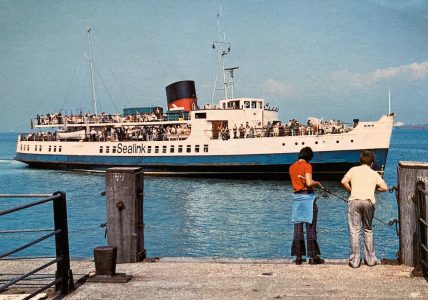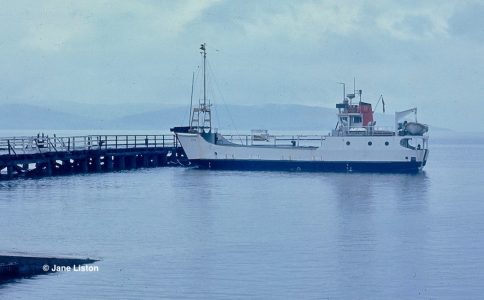
East India Harbour, Greenock, early 1955 — a painting by James Watt. The fishing boat in the foreground (Mary Pat) belonged to Andrew McFadden’s uncle, and it was a photograph of this scene, also featuring the MacBrayne steamships Lochness, Saint Columba and King George V in winter layup, that captured Andrew’s imagination as a boy
Graeme Hogg reflects on an evening of stark and entertaining contrasts. Below his report you can watch videos of all three presentations.
CRSC’s annual Members Night is always keenly anticipated but impossible to predict. This latest occasion, on 10 January in the Maldron Hotel, Glasgow, featured presentations by three members. It turned out to be a most enjoyable occasion: if you were not there, see for yourself by sampling the videos.
The evening started on a sombre note — with a tribute to the late John Whittle, who did so much to drive the modernisation of shipping services on the Clyde and Western Isles and, equally notably, arranged the sale of Waverley to the Paddle Steamer Preservation Society in 1974. His funeral had taken place in the afternoon, with CRSC president Robin Copland representing the Club.
The focus then moved to the main topic for the evening as Robin introduced our three speakers — all well kent faces aboard Waverley and CalMac ferries, not least on Club outings. Each identified what had fired their enthusiasm for the ships we all know and love.
First up was Paul Flint. As he himself admitted, Paul is not originally from these parts, having been born in Surrey, although he has now been resident in Scotland for many years. Railways were his first passion, to the extent that he became an engine driver and still drives freight trains from time to time. As a child he went to the Isle of Wight on the Denny-built ferries Shanklin, Southsea and Brading, but his passion for ships (and for Scotland) was really ignited when he had a family holiday on Arran in 1969, travelling on Glen Sannox and witnessing the visits to Brodick and Lochranza of Caledonia and Duchess of Hamilton.
When the family moved to Dover this love of ships grew as he observed and sailed on the channel ferries, especially Normannia, his favourite — one of many Denny ships in the British Rail fleet of the time.
From there we were taken on a journey covering trips to the Isle of Man on the classic turbine packets of the era, on schools cruises on the Uganda in the Mediterranean and later on the Russian ship Baltika from Saint Petersburg to Tilbury.
Paul later crossed the Atlantic on QE2 to visit his brother and spent a night on the former Cunard Queen Mary in Long Beach. He also organised work-related events aboard the original Queen Mary on the London Embankment. He is now a big supporter of Waverley .
In over 50 years of pretty regular attendance at Club meetings, I don’t remember participating in community singing, but all that changed when Jane Liston began her presentation. She opened with a lusty rendition of verse 1 of ‘The Song of the Clyde’ and the audience joined in for the chorus. This harked back to the days when, as a youngster living in Edinburgh, she would set off by car with her parents for holidays in Arran. The first year they stayed in Lamlash and thereafter in Blackwaterfoot. There were parallels with Paul’s Arran visit in that the ferry was Glen Sannox, and Caledonia and Duchess of Hamilton were observed but not sailed on, perhaps on grounds of cost.
Jane gave us vivid recollections of the experience of the family car being taken aboard the ‘Sannox’ on the hoist and into the garage and, prior to that, the magical first sight of the Arran hills on a clear day as Strathaven was reached on the cross country drive to Ardrossan. More harrowing was the occasion when the roof rack fell off the car as it traversed the String Road. Also of great interest were the copies of the hotel bills which have been retained for all these years.
In later years the Arran crossing was made on the lunchtime boat from Fairlie as this allowed for a later start from Edinburgh.
As she grew older and more independent, the need to go to Arran did not diminish. She was unimpressed with the car ferry Caledonia and much preferred Clansman when she appeared on the service later in the 1970s.
One of the latter’s most appealing features was the holders on the tables in the bar to keep beer glasses steady as the ship rolled. Jane’s visits have continued to the present day: she has witnessed the coming and going and coming again of Isle of Arran, and she enjoys going on Waverley from Largs to Brodick today as it nearly replicates the journeys of younger days.
The final speaker was Andrew McFadden, who titled his segment ‘From East to West’. His childhood home in Gourock overlooked Cardwell Bay, and there was a family connection with David MacBrayne. He would watch Lochfyne, his favourite, setting off at 09.30 every day except the Sabbath, bound for Tarbert or Ardrishaig, depending on the time of year.
His uncle’s small trawler was moored in the East India Harbour, where the MacBrayne turbines Saint Columba and King George V were laid up in winter: on the former ship Andrew’s mother had worked as a stewardess in the first class tearoom.

Andrew McFadden witnessed the final days of Ala ex Maid of Skelmorlie at Naples before she was broken up
That did not blind him to the charms of the Caledonian Steam Packet Company’s ships. He developed an early fondness for Waverley, becoming the youngest member of the Paddle Steamer Preservation Society. He continues to be a regular passenger on her.
A man of the cloth, Andrew served with the Royal Navy for many years, taking him to places that allowed him to indulge his love of ships. When based in Plymouth he could enjoy Kingswear Castle in her natural habitat on the Dart. While on naval service, he also had encounters with two old Clyde favourites — Keppel in Malta and the former Maid of Skelmorlie (renamed Ala) in Naples: he may have been the last Scotsman to see the latter ship before she was broken up.
One of Andrew’s fondest memories was evoked by a painting by James Watt, a distant relative, depicting his uncle’s trawler in the East India Harbour in 1955, overlooked by Lochness, Saint Columba and King George V: a poignant scene.
There can’t have been many nights at the Clyde River Steamer Club when the subject matter ranged from local waters to the Isles of Wight and Man, the Thames, St Petersburg, Switzerland, Malta, New York, California — and more. It was an excellent evening.
When you start the videos, please remember to click the box on the lower right-hand side to get the full screen version. Thanks to Robert Newth, John Newth and Roy Paterson for technical support.
CRSC is an association of friendly enthusiasts united by the quest to ‘meet together, sail together and talk together’, mainly on the west of Scotland — but many members hail from further afield. If you join us, you’ll receive copies of our much-prized west coast shipping Review and annual magazine, as well as access to a huge library of archive photos in the ‘Members Only’ section of this website. We gather for meetings and cruises throughout the year. To join us, click here.

After the event: Andrew McFadden, Jane Liston and Paul Flint in relaxed mood after delivering their CRSC presentations
Published on 14 January 2024













